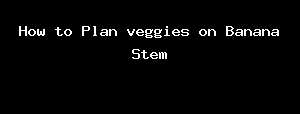Connect with me
profile/3450IMG_20230520_121000_218.jpg
Ngetichkyp

How To Plan Veggies On Banana Stem
~4.3 mins read
In the current world where majority suffer due to unemployment, agriculture remains to be the only option to escape the poverty circle.
In this article, am going to share with you organic agricultural practices that can generate you higher returns when you are determined.
This Farming solution will enable you to grow food for communities or your family and you won't always need expensive soil or large trucks of land in order to grow. You can sustain yourself with the things you already have. It is best practice for short-rooted plants e.g. kale, spinach etc.
Organic farming is gaining ground every day.Farmers have come up with innovative ideas, that can help empower both the rural and urban agricultural development activities.
By using the banana tree trunks for purposes of growing short root crops like kales, spinach etc, it has become easier for majority to yield huge out of the practice.
Using banana tree trunks for the purpose of growing veggies is very economical even when the dry season is on. This is because banana stems have been known for a long period of time, for having a good water retention capacity. As a result a few farmers have gone ahead to use this system for planting short root crops.
How to do you plant the Veggies on the stem?
The practice is not a rocket science, in fact it's one of the easiest, all you need to do is to have the banana stems, after that you will be required to add some little soil on the stem.
To add the soil on the stems, you need to make a hole, these holes can be made using a knife or sharp objects, once you've made the holes, you can therefore add a handful soil onto the holes.
Once the holes are filled with soil, you are ready to resume your normal planting process. You therefore need to transfer your veggies from the seed bed and transplant them in the holes.
This practice will yield you more returns weekly because it will minimize your irrigation expenses due to the fact that banana trunks hold so much water that can sustain your veggies even during the dry seasons.
Therefore if you have close to 100 banana stems, each stem would accommodate you between 10-15 veggies that being a total of between 1000-1500 veggies. If you harvest these veggies twice weekly, you are likely to pocket huge cash!
The current demographic world is undoubtedly becoming increasingly harder to practice agriculture in the large scale, therefore venturing in the organic farming will require less space which will guarantee you higher returns that you'll never expect.
It's high time you try this practice.. Don't wait, focus!
If you have any further clarification, kindly let me know in the comments section to guide you further. Remember to share this article with your friends..
Thanks!
profile/3450IMG_20230520_121000_218.jpg
Ngetichkyp

Best Beekeeping Tips To Follow
~0.9 mins read
Do you want to meet a reliable source of income with beekeeping? If yes, no need to worry. You have to read the advice below and go ahead and get started.
Here are the tips you should know in order to become a successful beekeeper.
1. Climate. This the first step you should consider before start beekeeping business. You have to know the correct environment. Bees do well in a warm tropical environment. Ensure that you locate well your beehive where it gets sunlight. You should also provide some shade to prevent excessive sunlight.
2. Ensure regular supply of nectars and pollens. After you have successfully located your beehive, ensure that you plant correct plants that produce flowers regularly. This will maintain the colony from swarming.
3. Be patient. You don't need to rush to harvest the honey early. You need to be patient a bit. You should know that the first year of your bees used to strengthen the colony. Harvest your honey after sixteen months.
4. Ensure there is a source of water near your Beehive. The bees need clean water to make honey, ensure you provide floaters by placing twigs on water.
5. Inspect your Beehive regularly. You should examine your Beehive regular to ensure it is well ventilated, especially during hot seasons.
Advertisement

Link socials
Matches
Loading...
